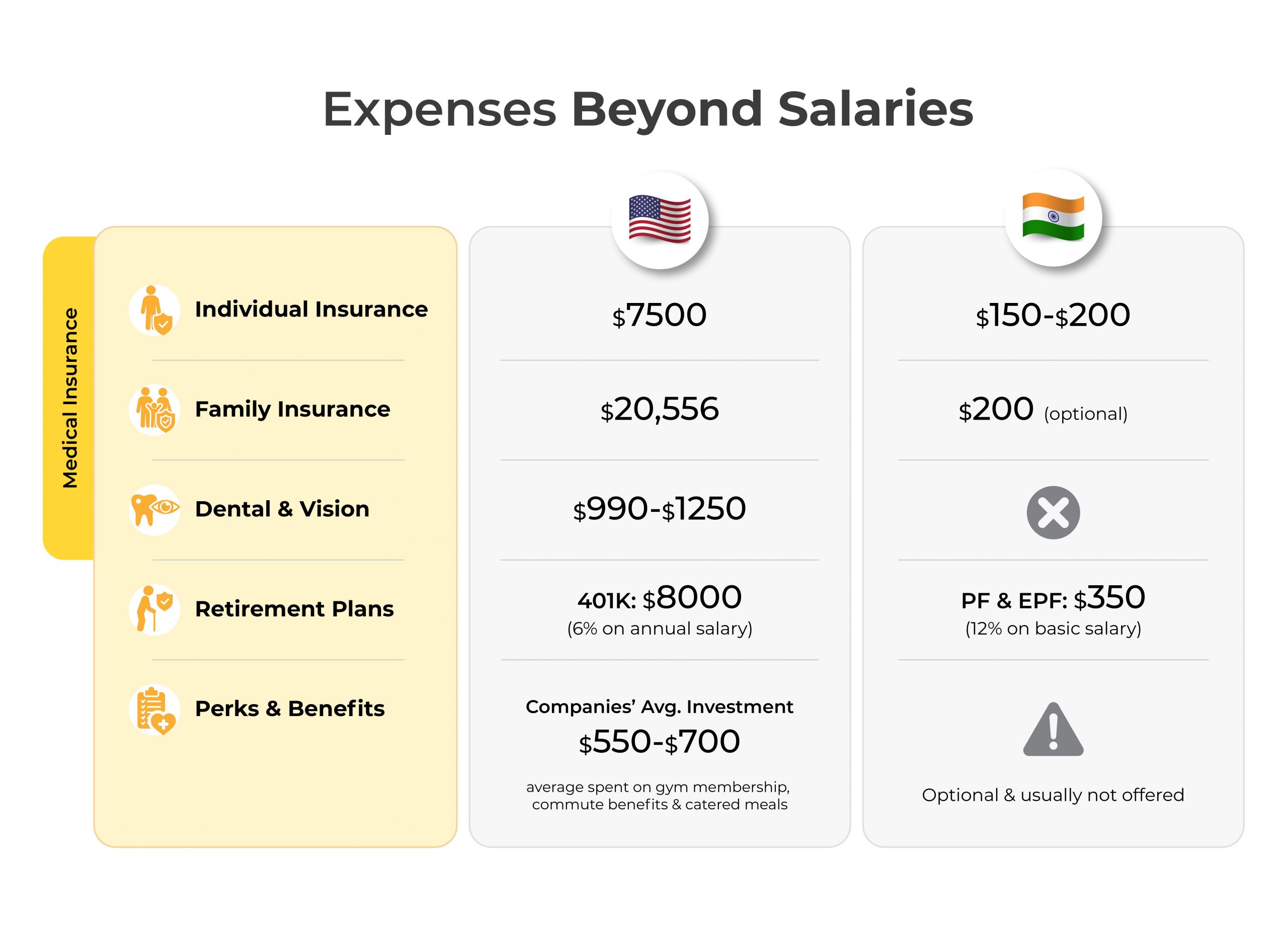Employee Compensation and Benefits To Hire Top Indian Remote Talent | Guide for Hiring Managers
- Ayushi Awasthi
- May 17, 2024
- 7 Minute Read

In the first quarter of the ongoing 2023-24 financial year (Q1FY24), there is a remarkable surge in demand for both tech and digital skills such as SEO, WordPress, Front-end development, ERP, Java, UI/UX design, and DevOps, etc.
Quess CEO Vijay Sivaram also highlights how the macroeconomic challenges such as geopolitical tensions, recessionary headwinds, and rising inflation impact the US and Europe and reveals a 25-30% decline in IT services sector hiring in local regions.
On the other hand, Global Capability Centers (GCCs) and multinational companies are turning to India to fill positions requiring expertise in SEO, UI/UX, WordPress, Front-end development, ERP, Java, Data Analytics, and Cloud due to India’s richest reservoir for tech talent. This trend aligns with a broader observation of a steady rise in demand for both tech and digital roles within the hiring paradigm.

However, HR professionals and decision-makers encounter multiple challenges in offering better compensation and benefits when hiring from India. Hence, organizations must ensure transparency in both pay structure as well as other benefits such as (medical insurance, retirement plans, other perks, and benefits) during the hiring process irrespective of their location – whether locally or overseas.
To hire top talent from India, it is also important to integrate better compensation and benefits plans to reduce the employee turnover rate in your organization.
In this blog, we will explore employee compensation and benefits and the key ways to gain a competitive edge for HR executives and decision-makers.
Here’s what statistics say about compensation planning when hiring remotely
If you are hiring remotely, especially from locations like India, employee benefits and compensation planning are more important than ever for decision-makers. Here’s why:
- According to a recent AIHR survey, World at Work (WTW) asked more than 2,000 US employers about their plans for pay raises in 2024. They found out that the average increase is expected to be 4 percent. This is a bit less than the 4.4 percent raise seen in 2023 and the 4.2 percent in 2022. But it’s higher than the 3.1 percent raise in 2021 and raises before the pandemic.
- Market data shows that 70% of the organizations increased base salaries in 2023, and over 64% hit their targets. This indicates a competitive job market where top talent commands strong salaries. By advertising a salary range, you can attract candidates who understand their worth and are aligned with your compensation structure.
- As per Korn Ferry’s Global Pulse Survey report, many organizations offer competitive increases (and potentially even exceeding targets by a 4-to-1 margin), and skilled candidates have options. Compensation planning allows you to target applicants who value your advertised range and also streamline your hiring process and who are more satisfied with your employee compensation and benefits package.
- The Payscale survey collected data from 1,757 companies in May and June 2023. It found that on average, salaries are expected to increase by 3.8% in 2024. Despite inflation and job market easing, wage growth is still high at 6.1% as of Q2 2023. Employers plan to maintain high pay increases this year to keep up with inflation and retain employees.
- Compensation planning builds trust with potential hires. It demonstrates that your organization values fairness and open communication. This can position you as an attractive employer in a competitive hiring market.

How do employers determine compensation and benefits when hiring from India?
Compensation and benefits are the total rewards an employer provides an employee in exchange for their work. This includes both monetary rewards, like salary and bonuses, and non-monetary rewards, like health insurance and paid time off.
- Compensation and benefits encompass both monetary and non-monetary rewards provided by an employer in exchange for work.
- It includes salary, bonuses, insurance, retirement contributions, and various other perks aimed at attracting, motivating, and retaining employees. For instance, in US companies, they offer 401K $8000 i.e, (6% on annual salary) while in India, employers offer PF and EPF as a retirement plan i.e, $650 (12% on basic salary).
- It’s the top factor considered by job seekers when accepting a new job and can account for up to 70% of business costs.
- While salary matters, the overall compensation package varies between jobs, with different perks such as bonuses, stock options, 401k matches, pension plans, and paid time off.
- Different countries emphasize different benefits; for instance, US companies on an average invest $550-$700 on gym memberships while In India, these perks are optional (usually not offered).
- In countries like France and Finland, employers provide additional benefits like restaurant vouchers covering part of the employee’s lunch.
The specific mix of compensation and benefits can vary depending on the country, company, and job.

What are the essential types of compensation every employer should consider when hiring an Indian talent?
Direct and indirect compensation offers various forms of rewarding employees beyond their base salary. Here’s a breakdown of the types of employee compensation and benefits:
Direct Compensation
- Base Pay: This is the fixed amount paid to an employee as per their employment contract, either annually, monthly, or hourly.
- Overtime Pay: Compensation for extra hours worked beyond the regular working hours, typically mandated by law for nonexempt employees.
- Variable Compensation: Rewards based on performance, often in the form of bonuses or commissions, aiming to motivate specific behaviors or outcomes, commonly used with sales teams.
- Sales Compensation: Specifically designed to motivate sales teams, typically combining a minimal base salary with commissions and bonuses tied to performance goals.
Indirect Compensation
- Equity: Offering employees a stake in the company through shares or stock options, aligning their interests with the company’s success.
- Benefits: Non-monetary offerings like health insurance, life insurance, retirement plans, and other perks aimed at protecting employees’ future well-being.
- Non-monetary Incentives: Rewards that enhance employees’ experiences, such as flexible working hours, wellness programs, extra time off, and various other perks designed to improve overall job satisfaction.

Key employee benefits for attracting Indian talent
When hiring from India, it’s important to consider the various employee benefits that can improve employee retention. Here’s a breakdown of employee benefits and compensation policy categories and what hiring managers need to know:
Legally Required Benefits (Statutory Benefits)
These benefits are mandated by Indian law and must be offered by all companies regardless of size or industry. Some examples include:
Provident Fund (PF)
A social security program where a portion of the employee’s salary is contributed towards their retirement.
Employees’ State Insurance (ESI)
Provides medical insurance coverage for employees and their dependents.
Gratuity
A payment made to an employee upon leaving the company after completing a minimum service period.
Paid Time Off (PTO)
PTO Includes vacation days, sick leave, and national holidays.
Discretionary Benefits
These are offered at the employer’s discretion and can be a significant factor in attracting and retaining top talent in India. Here’s a breakdown of some popular discretionary benefits:
Work-Life Balance
- Adobe’s report found that 84% of big company employees want some flexibility too. HBR’s survey ranks flexible hours as the second-best employee benefit.
- Some firms, like Airbnb, offer unlimited PTO, letting staff manage their leave as long as they do their job.
- Companies can provide different leave options, like sick leave, parental leave, holidays, bereavement leave, study leave, bad weather leave, volunteer time off, and more.
Health and Wellness
- Providing comprehensive health insurance beyond the mandatory ESI is a valuable benefit.
- As reported by Zippia 2023, these programs can reduce absenteeism and boost employee retention.
Financial Security
- A 2023 Morgan Stanley at Work study found 93% of Indian employees value retirement planning assistance.
- Offering life insurance provides financial security for employees’ dependents.
- Stock options/ownership/profit-sharing can incentivize employees and align their goals with the company’s success.
- Equipping employees with financial literacy programs to manage their finances improves their well-being.
Work Environment
- Funding for education, workshops, and certifications helps employees grow professionally.
- Work-life balance helps employees achieve better work-life balance especially in remote work. For example, providing on-site childcare, on-site grocery deliveries, dry cleaning services, and more.
By understanding these key benefit categories and their importance in the Indian workforce, hiring managers can create attractive compensation packages to hire and retain top talent from India.

What factors influence the design of compensation and benefits for remote Indian talent?
To effectively hire remote talent from India, GCCs and fast-paced tech companies need to carefully analyze salaries in their region vs in India. This helps them avoid hiring the wrong people which can hurt retention rates, slow down hiring, and lower productivity.
The crucial factor that hiring managers need to keep in mind while compensation planning is “salary analysis”, the first step should be doing comparative salary analysis when hiring talent from India. Here’s how it helps HRs and decision-makers-
- Hiring managers should prefer salary analysis tools to get real-time, verified data on salaries across different levels, roles, skills, experience, and locations. Understand how much you can save with salary market analysis.
- This salary analysis tool helps managers understand salaries of the same skills (SEO, web development, front-end, UI/UX, etc.) in your location vs India.
- The tool can also help you understand retirement plans, medical insurance, perks, and benefits US vs. India. This can guide you in creating a competitive compensation package to attract top talent from India.

Ready to hire talent from India with your compensation plan?
When considering a new hire, decision-makers must focus on offering transparency and parity in compensation and benefits structure. Providing adequate compensation is essential for hiring and retaining skilled and motivated Indian remote talents. Additionally, conducting a salary analysis is essential for developing a data-driven compensation strategy. Explore our Salary Analysis Tool to refine your compensation strategies and stay ahead in the hiring landscape.

Thank you for submitting the details!
We will keep your information safe. Feel free to contact us with any questions at hello@uplers.com
Please check your email for next steps shared by Robert.


![How to Hire an SEO Expert from India: Guide for Hiring Managers [+SEO Specialist Job Description Tips and Salary Analysis]](https://www.uplers.com/wp-content/uploads/2024/03/How-to-hire-an-SEO-expert-from-India-Guide-for-hiring-managers-Job-description-tips-and-salary-analysis-436x265.jpg)














